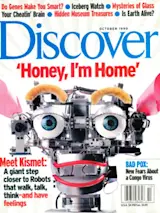One day in 1856, physicians in Norfolk, Virginia, hurried to a local brothel. One of the women there had gone into labor, and the birth wasn't going well. She was an achondroplastic dwarf, only 3 feet 6 inches tall. The baby's head was stuck in her deformed pelvis. In a vain attempt to save her life, doctors broke the child's skull, but still couldn't pull it through. Three days later, the mother died of childbed fever.
Mütter Museum
Her articulated skeleton, with its short arms and legs and disproportionately long head and torso, stands in a case at the College of Physicians of Philadelphia's Mütter Museum, next to those of a 7-foot 6-inch giant and a man of normal stature. At her feet lies the broken skull of her infant. Thomas Dent Mütter, a pioneering plastic surgeon and member of the college, brought together thousands of specimens like these, in a collection intended to teach medical students about normal and pathological anatomy.
The Mütter is one of the few great 19th-century medical museums remaining. With modern medical imaging and preservation techniques, today's schools no longer bother with old specimens. "Often they just toss them in Dumpsters," says museum director Gretchen Worden. When they do, she believes, they lose a priceless piece of medical history. "I had a well-known orthopedic surgeon from Israel who specializes in the shoulder and elbow taking photos like crazy, because he said you can't see all the details from the X rays."
The Mütter is also one of the few places to see late stages of now-treatable diseases. For example, says Worden, "Here we have syphilis out the wazoo." Wax models of faces eaten away by ulcers and lacy skulls riddled with what look like moth holes add punch to mild-sounding Shakespearean curses such as "A pox on both your houses."
The museum holds its treasures with dignity, and many specimens radiate a delicate, if grisly, beauty. Sets of teeth, some with a fringe of roots intact, balance on brass stands, looking like limestone stalactites. Saws, scalpels, and drills gleam in red velvet cases. Miscarried triplets, 14 weeks from term, float like fairies in a jar of preservatives. Other items, like an ovarian cyst the size of a Thanksgiving turkey, are harder to look at. And some, like a collection of twisted horns that once sprouted from human arms or foreheads, are just plain weird.
But visitors are invited not so much to gape as to explore the human capacity to triumph over adversity. Alongside a plaster cast of Chang and Eng, the famous conjoined twins whose autopsy was performed at the Mütter in 1874, stands a double-width ladder-back chair they once used. The poignant memento reminds us that patients are, first of all, people. --Polly Shulman
CD-ROMMars VE. MODERN SCHOOL SUPPLIES, 1999, $69.95.
Within the next 20 years, NASA hopes to launch the first manned voyage to Mars, sending several astronauts on a 27-month mission--18 months getting there and back plus nine on the planet's surface. The men and women who will make that journey are now in high school, just starting to contemplate their future careers. Perhaps some of them will be inspired by this superb CDR-ROM.
The setting for the adventure is an imaginary NASA research facility in the Mojave desert that has four interconnected domed laboratories. Each dome offers movies, lectures from NASA scientists, and other information to prepare armchair astronauts for a virtual trip to Mars. The challenge includes selecting landing sites best suited for various research projects: finding water, studying volcanoes, setting up a weather station, or searching for evidence of life.
The best place to begin the mission is inside the Mars Facts Dome, which features a time line comparing the development of Earth to that of Mars, a survey of myths about the Red Planet, and a history of past missions. Three and a half billion years ago, Mars, like Earth, was a warm, wet planet, a good place for life to evolve. This raises the wondrous question: Did Mars ever harbor life? The answer, whether yes or no, will have profound implications. If life did develop on two neighboring planets in one solar system, then it's probably common throughout the universe. If it didn't exist on a planet that was once so similar to our own, then we are more than likely alone.
In the Experts Dome, visitors encounter people like Jack Farmer, a NASA exopaleontologist who provides hints about where to look for the fossilized remains of Martian life. Chris McKay, an exobiologist, describes how Mars's surface, now one endless desert, still bears the scars of catastrophic flooding more than 1 billion years ago, and he offers advice on how astronauts might tap remaining Martian aquifers. The Planetary Exploration Dome introduces advanced robots, now under development at NASA, that will help with such tasks.
Most fun of all is the Landing Sites Dome, where viewers can roam various three-dimensional Martian landscapes--reconstructed from NASA photos--using a zoom-in feature to magnify the scenery. View the Valles Marineris, a vast canyon that would nearly stretch from New York to Los Angeles were it on Earth. Visit Chryse Planitia, an ancient floodplain, and find the remains of Viking, the lander that touched down there in 1976. Or gaze up at 16-mile-high Olympus Mons, a huge volcano three times taller than Mount Everest.
The disk comes with a teacher's guide and a student workbook filled with suggestions for supplementary classroom exercises and experiments. But they aren't required for anyone who just wants to have a little fun at home and glimpse what a happy few may one day experience firsthand. ----Tim Folger
Book Excerpt From The Pleasure of Finding Things Out
By Richard P. Feynman.














